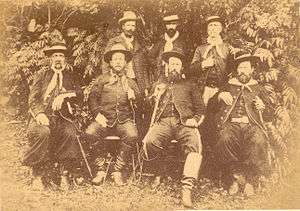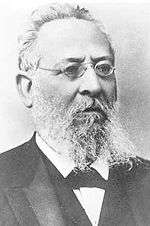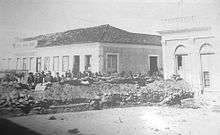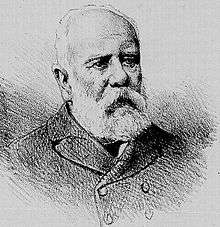Federalist Riograndense Revolution
| Brazilian Federalist Revolution | |||||||
|---|---|---|---|---|---|---|---|
| Part of Brazilian Naval Revolt | |||||||
 Gumercindo Saraiva and Maragato commanders. | |||||||
| |||||||
| Belligerents | |||||||
|
|
| ||||||
| Commanders and leaders | |||||||
|
|
| ||||||
| Strength | |||||||
| 22,000 soldiers and militia |
7,500 federalist rebels ~500 rebel sailors | ||||||
| Casualties and losses | |||||||
| 10,000 killed | |||||||
The Federalist Riograndense Revolution (1893 - 1895) was a civil war which occurred in southern Brazil against the recently-formed Republic. Urged by the political crisis generated by the federalists, an opposition group that sought to liberate Rio Grande do Sul from the governance of Julio de Castilhos, then president of the state, and also gain greater autonomy and decentralize the power of the then newly proclaimed Republic.
Inspired by the monarchist ideologies from Gaspar da Silveira Martins, it had Gumercindo Saraiva as the military head. The revolutionaries, known as Maragatos, engaged in bloody disputes that eventually triggered the armed struggle, until they faced defeat in the Battle of the Pulador, in 1894, by the troops of Pinheiro Machado, but peace was only concluded definitively on the following year.
The conflict reached the three states of the region: Rio Grande do Sul, Santa Catarina and Paraná, causing about 10,000 deaths.
Context
During the nineteenth century, the state of Rio Grande do Sul was in a permanent state of war. In the Ragamuffin War (1835-1845) and in the War of the Triple Alliance (1864-1870), the population of Rio Grande do Sul was devastated. In the last years of the Brazilian Empire, three antagonistic political leaders appeared in the region: the liberal Assis Brasil, the conservative Pinheiro Machado and positivist Júlio Prates de Castilhos. The three met to found the Rio Grande Republican Party, which opposed the Federalist Party of Rio Grande do Sul, founded and led by the liberal monarchist Gaspar da Silveira Martins. In 1889, with the Proclamation of the Republic, these currents came into conflict, so that in only two years the state would have eighteen governors.
Panorama of Castilhos

Júlio Prates de Castilhos was born and raised in a gaucho resort and studied Law in São Paulo, where he had contact with the positivist ideas of Auguste Comte. After graduating, he returned to his homeland and began to write in the newspaper The Federation (Brazilian Portuguese: A Federação), attacking the monarchical government, slavery and his political opponent Gaspar da Silveira Martins. He was a constituent congressman in 1890-1891, and believed in a dictatorial phase to consolidate the Republic and defended a strong centralization of power in the republished dictator. Defeated in the national constituent, he implanted this idea in the state constitution, months later, in a text he wrote almost alone, ignoring suggestions from the commission of jurists highlighted for the task, and approved it in July 1891 at a controlled state assembly By the Riograndense Republican Party, led by him and of positivist orientation. The state constitution foresaw that the laws would not be drafted by parliament, but by the chief executive, who could be re-elected for new mandates. As the vote was not secret, the elections would be easily manipulated by the followers of Castilho, which would guarantee him to remain in power indefinitely.
In the same month that he approved his constitution, he was elected governor. In November, for having supported the coup of President Deodoro da Fonseca and the closing of the Congress, was deposed and replaced by a junta of government, that lasted little and soon passed the government to general Barreto Leite. Castilhos resumed a parallel government and was reelected in a contest without competitors, taking possession in January 1893. At that moment, the state was the "nerve point of the Republic" and the answer of the opponents was imminent.
Panorama of Martins

Gaspar da Silveira Martins, an intellectual and a good speaker, had been appointed minister by Emperor Pedro II in one of his last acts in an attempt to save the monarchy. Prisoner and exiled in Europe, returned in 1892, with the state already under the government of Júlio de Castilhos and founded the Federalist Party of Rio Grande do Sul, that defended the parliamentary system of government and the revision of the state constitution. With the possession of Castilhos, the caudillo Gumercindo Saraiva would also return to the state, coming from his refuge in Uruguay and leading a troupe of five hundred men. A second group, commanded by General Joca Tavares, occupied another region of the state with a force of three thousand men. Threatened, the governor convinced the then President Floriano Peixoto that the uprising was an attempt by Silveira Martins to restore the monarchy. And indeed, it was. Silveira Martins, for being a declared monarchist, participated in meetings with other Brazilians who had the objective of restoring the parliamentary monarchy in Brazil. On that occasion he proposed to Isabel, Princess Imperial of Brazil to allow the soldiers linked to the Navy Revolt to take her eldest son, Pedro de Alcântara, Prince of Grão-Pará, to be acclaimed as Emperor Pedro III, whom the princess refused to fear for her son.
Pica-paus and Maragatos
The followers of Gaspar da Silveira Martins, gasparistas or Maragatos (federalists), were frontally opposed to the followers of Júlio de Castilhos, castilhistas, pica-paus (woodpeckers) or ximangos (republicans).
The defenders of Júlio de Castilhos received the nickname of pica-paus or ximangos, because of the color of the uniform used by the soldiers who defended that faction, that resembled the birds of the region. This denomination extended to all the castilhistas, including civilians. Already the term maragato, which was used to refer to the political current that Gaspar da Silveira Martins defended, has a more complex explanation:
"In the province of Leon, Spain, there is a district called Maragateria, whose inhabitants have the name of maragatos, and that, according to some, it is a town of condemnable customs; therefore, living to wander from one point to another, with Freighters, selling and buying robberies and in turn robbing animals, they are a species of gypsies." -Romaguera.
The Spanish maragatos were eminently nomadic, and adopted professions that allowed them to be in constant displacement. In Uruguay, the inhabitants of the city of San José de Mayo were called maragatos, perhaps because their first inhabitants were descendants of the Spanish maragatos, who were responsible for bringing to the region of the River Plate the custom of the bombacha.
At the time of the revolution, legalistic republicans used this appeal as pejorative, with the meaning of "mercenaries." The reality offered some basis for this assertion - the leader Gumercindo Saraiva, one of the leaders of the revolution, had entered Rio Grande do Sul from Uruguay by the border of Aceguá, in the Department of Cerro Largo, commanding a troop that included natives from that country. The family of Gumercindo, although of Portuguese origin, had fields in Cerro Largo. However, giving this nickname to the revolutionaries was a backfire. The denomination gained sympathy, and the rebels themselves came to be denominated maragatos. In 1896, they even created a newspaper bearing that name.
The War
Beginning

The disagreements began with the concentration of troops under the command of the maragato João Nunes da Silva Tavares, the Joca Tavares, Baron of Itaqui in fields of the woodworking, in Uruguay, locality near Bagé. Shortly after the potrero of Ana Correia, coming from Uruguay towards Rio Grande do Sul, was the federalist caudillo colonist Gumercindo Saraiva.
Efficiently, the maragatos dominated the border, demanding the deposition of Julio de Castilhos, who had been elected president of the state by direct vote. There was also the desire for a plebiscite where the people should choose the system of government. Due to the gravity of the movement, the rebellion quickly acquired nationwide, threatening the stability of the Riograndense government and the republican regime throughout the country. Floriano Peixoto, then in the Presidency of the Republic, sent federal troops under the command of general Hipólito Ribeiro to rescue Júlio de Castilhos. There were strategically organized three divisions, called legalists: the northern, the capital and the center. In addition to these, the state police and all its contingent were summoned to confront the enemy.
The first victory of the maragatos was in May 1893, next to the brook Inhanduí, in Alegrete, Riograndense municipality. In this fight along with the legalistic pica-paus took part Senator Pinheiro Machado, who had left his seat in the Federal Senate to organize the Division of the North, that led during all the conflict.
Maragatos advance

Gumercindo Saraiva and his troops went to Dom Pedrito, from there they began a series of lightning attacks against several points of the state, destabilizing the positions conquered by the Republicans. Then they headed north, advancing in November on Santa Catarina and arriving in Paraná, being detained in the city of Lapa, sixty kilometers southwest of Curitiba. At the time, then President Marshal Floriano Peixoto summoned veteran of the Paraguayan War Colonel Gomes Carneiro. His orders were to halt the revolution. In five days, he came to the area to replace General Argolo. It was November 1893 and the revolutionary troops were now advancing towards the state of Paraná. On this occasion, Colonel Carneiro died in February 1894 without giving its positions to the enemy, in the episode that became known as the Siege of Lapa. The obstinate resistance opposed to the federalist troops in the city of Lapa, by Colonel Carneiro, frustrated the rebellious pretensions to arrive at the capital of the Republic.
In the capital, the Revolt of the Navy began, under the leadership of the monarchist Admiral Custódio José de Melo, who also fought against Floriano. After some exchange of gunfire with the army, the rebels went to the South. After docking in the city of Desterro, renamed to Florianópolis after the war, they proclaimed the city as a new capital. Interests meant that the two revolts came to join.
"They have joined forces to overthrow Floriano. By sea, Custódio de Melo was responsible for striking Paranaguá, which happened in January 1894" says the judge and scholar Paul Hapner. By land, Gumercindo Saraiva advanced towards the state capital.[1]
Siege of Lapa

In the same period that the coast was taken, the Maragatos passed by Tijucas do Sul and came to Lapa - only 60 km away from Curitiba, capital of the state of Paraná.
The state was in chaos. With the advance of the rebels, the state governor, Vicente Machado, fled from Curitiba. With only 639 men, few weapons and food shortages, Colonel Carneiro had a mission to contain the Federalists in Lapa. During 26 days, Carneiro and his army, called woodpeckers (Brazilian Portuguese: Pica-paus), bravely resisted the attacks of 3000 fighters commanded by Gumercindo Saraiva. "The troops of maragatos made a real siege to the city," says Hapner. At least 500 people died in the Siege of Lapa, including Carneiro. With the death of the commander in February, Lapa surrendered and left the passage open for the revolutionaries to take Curitiba.[2]
Despite the defeat, the battle in Lapa was critical for the Republican victory. Hapner considers the siege to have been a strategic error of the Maragatos: "If they wanted to go to Rio de Janeiro, they should not have wasted time in Lapa. This gave Floriano's army enough time to organize, ultimately defeating the Federalists", he says.
For the historian Dennisson de Oliveira, "This was a mythical episode that, to the power established under Floriano, 'saved' the Republic."[1]
After the battle, Gumercindo Saraiva, unable to advance, retired to Rio Grande do Sul. He died on 10 August 1894, after being shot by treason while recognizing the terrain on the eve of the Battle of Carovi.
Release of Curitiba
After taking Paranaguá, Tijucas do Sul and Lapa, and with the absence of govern and military forces in Paraná, the rebels easily entered Curitiba. According to scholar Paul Hapner, evacuation of loyalist troops caused chaos in the city. Gumercindo Saraiva and Custódio de Melo had no obstacle. They appointed a governor - Colonel Theophilus Gomes Soares, who remained in power for only 4 days. "Then they gathered in a mansion that existed in the Alto da Glória and appointed another governor, João Menezes Doria, who remained until March" reports Hapner.
After him, two others were appointed governors. The last Maragato governor in Paraná was José Antonio Ferreira Braga, in early May 1894.[1]
Osório field
It was the last battle of the uprising, held along the border with Uruguay. Admiral Saldanha da Gama, with the Federalists, led 400 rebels, 100 of which being revolting navy sailors. They were attacked by a cavalry regiment of the Brazilian army that counted 1,300 cavalrymen, led by General Hipólito Ribeiro. In the course of the battle, Admiral Saldanha da Gama, twice wounded by spears, was killed along with most of his men, many executed by sticking after surrender. The victorious Legalists suffered about 200 casualties.
End
.jpg)
The federalists demanded further "war loans" not to sack Curitiba. The population was restless. It was during this period that Ildefonso Correia Pereira, the Baron of Serro Azul, devised a plan to rid the city from the Maragatos.
The Baron considered fighting in the city unnecessary as it would spill more blood; and so he made the decision to negotiate. In return for peace and the absence of looting, the Baron secretly lent, with the support of some traders, money to Gumercindo Saraiva, head of the Maragatos. The negotiations, however, were seen as betrayal by the defenders of Floriano.
Thus, Maragatos left the city in May and Vicente Machado returned to power. However, Serro Azul and five companions were kidnapped. They were taken by train towards Paranaguá, under the pretext that they would board a ship headed towards Rio de Janeiro, where they would receive an award, but it was a trap. The Baron of Serro Azul and his allies were unloaded from the train and shot in the Serra do Mar, accused of treason for negotiating with the Maragatos.[1]
Foreign involvement
Throughout the Revolution, the maragatos had constant support of the province of Corrientes, in Argentina and also in Uruguay. This allowed them to smuggle arms across the border, to practice tactical raids on foreign territory in order to escape persecution, and to take refuge in neighboring countries at times of disadvantage vis-à-vis the enemy.